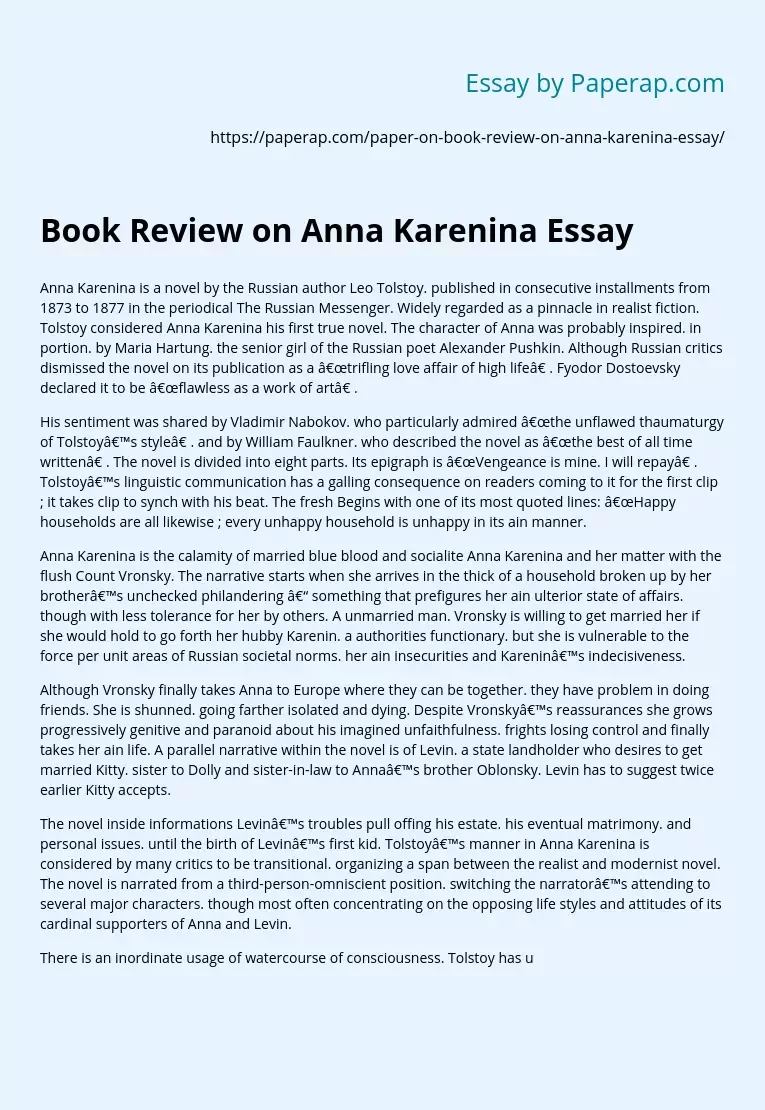Book Review on Anna Karenina Essay
Anna Karenina is a novel by the Russian author Leo Tolstoy. published in consecutive installments from 1873 to 1877 in the periodical The Russian Messenger. Widely regarded as a pinnacle in realist fiction. Tolstoy considered Anna Karenina his first true novel. The character of Anna was probably inspired. in portion. by Maria Hartung. the senior girl of the Russian poet Alexander Pushkin. Although Russian critics dismissed the novel on its publication as a “trifling love affair of high life” . Fyodor Dostoevsky declared it to be “flawless as a work of art” .
His sentiment was shared by Vladimir Nabokov. who particularly admired “the unflawed thaumaturgy of Tolstoy’s style” . and by William Faulkner. who described the novel as “the best of all time written” . The novel is divided into eight parts. Its epigraph is “Vengeance is mine. I will repay” . Tolstoy’s linguistic communication has a galling consequence on readers coming to it for the first clip ; it takes clip to synch with his beat.
The fresh Begins with one of its most quoted lines: “Happy households are all likewise ; every unhappy household is unhappy in its ain manner.
Anna Karenina is the calamity of married blue blood and socialite Anna Karenina and her matter with the flush Count Vronsky. The narrative starts when she arrives in the thick of a household broken up by her brother’s unchecked philandering – something that prefigures her ain ulterior state of affairs. though with less tolerance for her by others. A unmarried man. Vronsky is willing to get married her if she would hold to go forth her hubby Karenin.
a authorities functionary. but she is vulnerable to the force per unit areas of Russian societal norms. her ain insecurities and Karenin’s indecisiveness.
Although Vronsky finally takes Anna to Europe where they can be together. they have problem in doing friends. She is shunned. going farther isolated and dying. Despite Vronsky’s reassurances she grows progressively genitive and paranoid about his imagined unfaithfulness. frights losing control and finally takes her ain life. A parallel narrative within the novel is of Levin. a state landholder who desires to get married Kitty. sister to Dolly and sister-in-law to Anna’s brother Oblonsky. Levin has to suggest twice earlier Kitty accepts.
The novel inside informations Levin’s troubles pull offing his estate. his eventual matrimony. and personal issues. until the birth of Levin’s first kid. Tolstoy’s manner in Anna Karenina is considered by many critics to be transitional. organizing a span between the realist and modernist novel. The novel is narrated from a third-person-omniscient position. switching the narrator’s attending to several major characters. though most often concentrating on the opposing life styles and attitudes of its cardinal supporters of Anna and Levin.
There is an inordinate usage of watercourse of consciousness. Tolstoy has used existent events in his narrative. to impart greater verisimilitude to the fictional events of his narrative. Characters speak of the important sociopolitical issues impacting Russia in the latter half of the 19th century. like the topographic point and function of the Russian provincial in society. instruction reform. and women’s rights. Tolstoy communicates his ain political beliefs through this novel.
He includes in the transcript. his ain analysis of the political orientations. behaviours. and thoughts running through modern-day Russia through the ideas of Levin. The wide array of state of affairss and thoughts depicted in Anna Karenina allows Tolstoy to show a treatise on his Russian epoch. and. by virtuousness of its very comprehensiveness and deepness. all of human society. This stylistic technique. every bit good as the novel’s usage of position. greatly contributes to the thematic construction of Anna Karenina.
The novel is fundamentally a twit on Russian nobility although Tolstoy himself was a portion of it. It emphasizes on the impressions of lip service. green-eyed monster. religion. fidelity. household. matrimony. contrivance. society. advancement. animal desire and passion. and the agricultural connexion to land in contrast to the life styles of the metropolis. There is a point raised on the extramarital affairs and the lower status composite for talking French alternatively of Russian linguistic communication. in the Russian Aristocratic society. Tolstoy allows his subjects to emerge of course from the “vast view of Russian life.
The fresh sends a message that “no one can construct one’s felicity on another’s hurting. ” Anna karenina implicitly shows the “respect” and “honour” given to adult females in western society which debates on Human Rights. Western society is non an exclusion. adult females largely considered to be the marionettes irrespective of the societies. This is why Allama Iqbal negotiations about the hollowness of the western society. Islam takes a moderated attack for adult females. There are limitations but her function is besides justified in the society.
Book Review on Anna Karenina Essay. (2017, Jul 24). Retrieved from https://paperap.com/paper-on-book-review-on-anna-karenina-essay/

